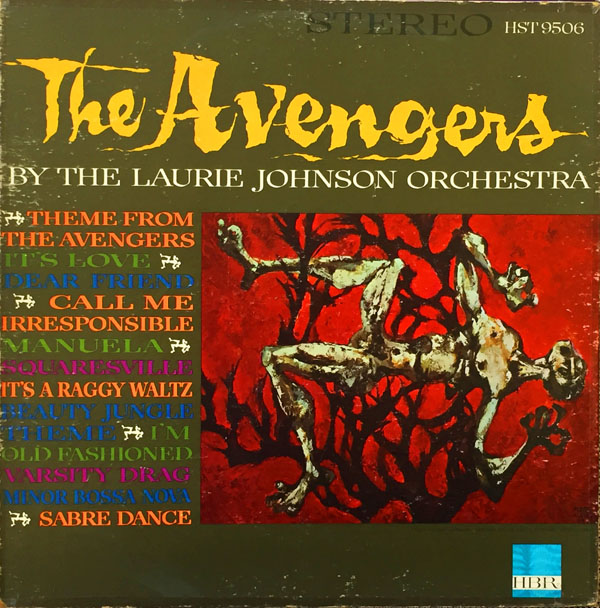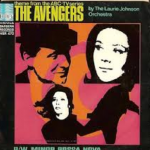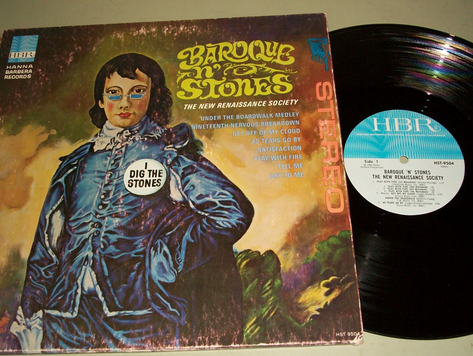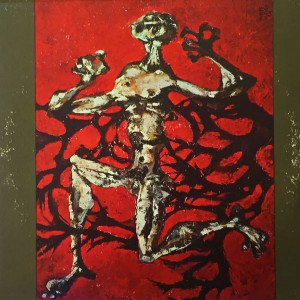Super Snooper and Blabbermouse encounter Gold Pinky, Dr. Oh No and 007 himself (sort of) in a smashingly superb record album from 1965.

Hanna-Barbera Presents
“JAMES BOMB”
Starring SUPER SNOOPER & BLABBERMOUSE
Hanna-Barbera Records Cartoon Series HLP-2036 (12” 33 1/3 RPM / Mono)
Condensed Story Version: Hanna-Barbera CS-7020 (7” 45 RPM)
Songs Only Version: Hanna-Barbera CS-7053 (7” 45 RPM)
Released in 1965. Executive Producers: William Hanna, Joseph Barbera. Producer/Writer/Director: Charles Shows. Music: Hoyt Curtin, Ted Nichols (H-B Stock Library). Song Arrangements: Al Capps, Stan Farber. Editor: Dan Finnerty. Sound Effects and Music Editing: Tony Milch. Engineer: Richard Olsen. Mastering: Dave Diller, Joe Leahy. Art Direction: Harvard Pennington. Hand Lettering: Robert Schaefer. Cover Art: Iwao Takamoto, Paul Julian. Running Time: 33 minutes.
Voices: Daws Butler (Super Snooper, Blabbermouse, Dr Oh No, Killer, LBJ); Don Messick (Gold Pinky, Narrator, Newscaster); Ricky Page, Stan Farber, Al Capps, Ron Hicklin (The Hanna-Barbera Singers).
Songs: “Super Snooper” by Larry Goldberg, Lynn Bryson, Charles & Peggy Shows; “Gold Pinky,” “Dr. Oh No,” “James Bomb” by Stan Farber and Charles & Peggy Shows.
While James Bond battles SPECTRE (Special Executive for Counter-intelligence, Terrorism, Revenge and Extortion), Super Snooper, Blabbermouse and James BOMB must save Washington DC from SQUISH (Society of Uncouth and Quarrelsome Idiots and Secret Horrors). That’s the twist in this clever HBR groove on the Bond craze—putting Snoop and Blab in the clutches of supervillains Dr. Oh No and Gold Pinky.
Even though James Bond movies continue to be big tentpole events today, they’re still not as earth-shaking as they were during the 1960’s Cold War era. Bond mania was at such a fever pitch that–figuratively–you couldn’t throw a rock and not hit something either inspired by, or spoofing, Ian Fleming’s international superspy.
 Saturday morning TV was getting into the act with King Features’ Cool McCool and Hanna-Barbera’s Secret Squirrel Show (recently released on DVD by Warner Archive). Super Snooper and Blabbermouse (aka “Blabber Mouse” or just “Blabber”)—the stars of a cartoon segment of “The Quick Draw McGraw Show”—were already private eyes, so it wasn’t as much of a stretch to fit them into a spy caper as it was for Mister Ed and Wilbur (yes, they really did episodes in which the talking horse took on international spies).
Saturday morning TV was getting into the act with King Features’ Cool McCool and Hanna-Barbera’s Secret Squirrel Show (recently released on DVD by Warner Archive). Super Snooper and Blabbermouse (aka “Blabber Mouse” or just “Blabber”)—the stars of a cartoon segment of “The Quick Draw McGraw Show”—were already private eyes, so it wasn’t as much of a stretch to fit them into a spy caper as it was for Mister Ed and Wilbur (yes, they really did episodes in which the talking horse took on international spies).
One of the first original stories in the Hanna-Barbera Records Cartoon Series (the earlier albums being based on classic stories), “James BOMB” is a winner from start to finish. Even the groovy original songs–which sometimes seemed out of place on other HBR discs–work like charms, especially “Gold Pinky”, which showcases the impressive range of “Bamm-Bamm” singer Ricky Page. (Two previous HBR tunes make a repeat appearance as well: “Monster Shindig”, which always seemed to be on everyone’s radio in a funny gag that ran throughout the albums, and the “Super Snooper” song from the “Shindig” LP.)
Humorous action-adventure was writer Charles Shows’ strength. The James BOMB album builds to an exciting and funny denouement just as it did on Robin Hood Starring Top Cat. Shows’ classic radio comedy/drama formula, which relies on back-and-forth conversation between two characters to fill in plot details and convey the visual aspects, can sometimes pad the dialogue (as it does on Jonny Quest in 20,000 Leagues Under the Sea, but in the case of “James BOMB”, Shows makes it part of the comedy.
For example, when Dr. Oh No explains his plans to Gold Pinky (but actually to the listeners), what could have been a lot of dry exposition is buoyed by Gold Pinky’s constant nagging, “What about the gold?” Shows breaks up the exposition and gives Gold Pinky (who is otherwise not much more than Oh No’s sidekick) a little more comic dimension.
And let’s face it, how can anyone go wrong with Daws Butler and Don Messick? They do every voice on the album—with Butler carrying on conversations among as many as three characters, yet each personality is separate and distinct. The most nuanced, flesh-and-blood performance by Butler is that of Dr. Oh No, a psychopath with touches of George Sanders (and of course, Joseph Wiseman, who played Dr. No in the first Bond film). The “good doctor” speaks with such a tense, measured calm, it suggests the rage beneath–a level head teetering on the edge of madness. This is the classic Bond villain through and through, interpreted by Butler with complete seriousness in the midst of spoofery. And what is most astonishing is that only a fraction of that personality comes from the script.
For instance, when hitman Killer protests taking Snoop and Blab out of the shark pool, On No says, quietly, “I said…bring them here.” It is with that tone and pause that the listener learns how Killer is intimidated by the consequences of disobeying Oh No. Nearly all of Side One is dominated by the Doctor, with James BOMB picking up the lead on Side Two (another HBR story technique of dividing the story focus between each side of the record).
Don’t tell Action For Children’s Television, but this is a pretty violent children’s record with lots of gunplay, two possible deaths and what would today be considered a terrorist threat. Even the album cover—a tour de force by Iwao Takamoto and Paul Julian—is the sort of thing that would set hands a-wringing by the 1970s. Good gravy Marie! How did we kids survive such corrupt influences?
GIVE A LITTLE LISTEN
“James BOMB’s Flying Rolls-Royce”
A masterwork of comic timing, seemless editing and fine writing that reminds one of Stan Freberg’s immortal “building a sundae in Lake Michigan” radio spot. Note how much of Blabbermouse’s dialogue is descriptive. That kind of exposition can be a challenge to write and perform, because it can so easily be forced and contrived, but in the skilled hands of Shows and Butler, it arises naturally from character and situation.

THE AVENGERS
Theme from the ABC Television Series & Other Favorites
The Laurie Johnson Orchestra
Hanna-Barbera Records (U.S.) HST-9506 (Stereo) HLP-8506 (Mono) (12” LP)
Pye Records (U.K.) LP Release: Pye Records NSPL-30084
U.K. Reissue: Marble Arch Records MAL-695 (1967)
(Also in 45 RPM on Hanna-Barbera and Pye Records)
Released in 1966. Arranger/Conductor: Laurie Johnson. Cover Art (HBR): Fernando Montealegre. Recorded at Landsdowne Studios, London. A Pye U.K. Recording. Running Time: 33 minutes.
Laurie Johnson Music: “Theme from The Avengers”, “Manuela”, “Squaresville”, “It’s a Raggy Waltz”, “Beauty Jungle Theme”, “Minor Bossa Nova”.
Other Selections: “It’s Love,” by Betty Comden, Adolph Green, Leonard Bernstein; “Dear Friend” by Jerry Bock, Sheldon Harnick; “Call Me Irresponsible” by Sammy Cahn, Jimmy Van Heusen; “I’m Old Fashioned” by Jerome Kern, Johnny Mercer, “Varsity Drag” by Buddy DeSilva, Lew Brown, and Ray Henderson; “Sabre Dance” (Traditional).
 One of the all-time greatest 007-inspired creations of the 1960s is the British confection, “The Avengers”, an adventure/fantasy series that predates the Marvel “Avengers” by two years. This “Avengers” began life as a standard crime and espionage series about a doctor (Ian Hendry, spouse of Disney favorite Janet Munro) who finds himself immersed in intrigue with a mysterious partner named John Steed (Patrick Macnee).
One of the all-time greatest 007-inspired creations of the 1960s is the British confection, “The Avengers”, an adventure/fantasy series that predates the Marvel “Avengers” by two years. This “Avengers” began life as a standard crime and espionage series about a doctor (Ian Hendry, spouse of Disney favorite Janet Munro) who finds himself immersed in intrigue with a mysterious partner named John Steed (Patrick Macnee).
When Hendry departed and Macnee became the lead, he was paired with pre-“Goldfinger” co-star Honor Blackman. After Blackman left the TV show for a big screen career, the series was picked up for U.S. broadcast by ABC-TV.
Because ABC picked up half the tab, the series upgraded its format from live/videotape to film, became more lavishly produced in a picture-postcard style (deliberately geared to appeal to American audiences), and caught lightning in a bottle by casting Diana Rigg (now Dame Diana) as Emma Peel–the prototype of every cat-suited, judo-kicking ultrawoman in popular culture. The chemistry between Macnee and Rigg was kinetic, the stories became more fantastic, and a TV cult classic was born (subsequent Macnee patnering with Linda Thorson and Joanna Lumley were quite superb as well).
Promo film for the 1968 season of “The Avengers”:
Laurie Johnson’s crisp, witty musical scores were part of the series’ charm. His iconic theme music perfectly captured the sparkling elegance in musical form. When “The Avengers” became an international hit, the theme traveled around the world on records—first on the PYE label in Britain, then on—guess what?—the fledgling Hanna-Barbera label in the U.S.
Under the A&R supervision of Larry Goldberg (who also co-wrote several songs on the Cartoon Series LP’s), Hanna-Barbera Records was looking to become a mainstream label, signing singers like Earl Gains and Jean King, groups like The Five Americans, and instrumentalists like Gloria Tracy. There was even a beach party movie soundtrack: “A Swingin’ Summer”.

There are quite a few articles on the web chronicling this aspect of the HBR label. Chief among them is this excellent history by Kliph Nesteroff; an account focusing on HBR 45 RPM singles and an interview with Danny Hutton.
The HBR album is identical to the Pye LP. There is no “Avengers”-related material included other than the theme song. As a composer, Johnson was already renowned for such films as “Tiger Bay” (Hayley Mills’ movie debut) and “Dr. Strangelove”. In animation, he’s a latter-day Raymond Scott, as the composer of countless “needle drops”, low-cost production library music used in commercials and films. Several of Johnson’s melodies, such as “Happy Go Lively” are so irresistibly campy that they were used on “The Ren & Stimpy Show”, “Spongebob Squarepants” and other cartoons.
H-B artist Harvard Pennington was the Art and Photography Director for the mainstream records as well as most of the Cartoon Series titles. It’s interesting to see how record album covers and single picture sleeves were interpreted by H-B artists, particularly hand letterer Robert Schaefer (though some were also done by freelancers).Artistically, HBR’s “Avengers” LP is very strange indeed. Although the 45 RPM release featured the likenesses of Rigg and Macnee, the LP displayed a painting of an unclad, pain-stricken body surrounded in web-like strands. A closer glance reveals that this art was created (and signed) in 1964 by H-B background artist Fernando Montealegre. My guess is that Pennington simply used Montealegre’s painting for the cover and there was no other connection between it and “The Avengers”. (I must admit that, in my youth, this image creeped me out, especially as it contrasted to the blithe, playful tone of “The Avengers” TV show.)
GIVE A LITTLE LISTEN
“Theme from the TV Series THE AVENGERS”
An expanded version, combining the main and end titles, of the theme. It was most likely recorded by the same orchestra–perhaps at the same session–as the TV soundtrack rendition, since the sound quality is identical. What a joy it is to hear it in full stereo!
This is the actual TV version:







 GREG EHRBAR is a freelance writer/producer for television, advertising, books, theme parks and stage. Greg has worked on content for such studios as Disney, Warner and Universal, with some of Hollywood’s biggest stars. His numerous books include Mouse Tracks: The Story of Walt Disney Records (with Tim Hollis). Visit
GREG EHRBAR is a freelance writer/producer for television, advertising, books, theme parks and stage. Greg has worked on content for such studios as Disney, Warner and Universal, with some of Hollywood’s biggest stars. His numerous books include Mouse Tracks: The Story of Walt Disney Records (with Tim Hollis). Visit 





















































Greg:
Very,very cool posting this time around!!! Wish we could hear more of the Super Snooper-Blabbber Mouse-James Bomb album! Well done by all involved! And the Avengers theme (both versions) were truly hip!! Along with the clip from the “68 season promo film(though I can’t for the life of me,figure out why Steed abandoned Mrs. Peel for another bird!!! Oh well,thanks for another great post!!!
Thanks, Andy! I usually post edited excerpts for Spin, but someone else did post the the entire album on YouTube.
The James Bomb album exploits the silliness inherent in the Bond franchise–the extreme super-weapons, the shallowness of the villains and their motives, etc. (Unfortunately, it doesn’t play up the pretty girl angle, but the H-B scribes took care of that when they scripted “The Man Called Flintstone” feature film which involves Fred with a bevy of beauties.) For a 30-minute record, the James Bomb album packs quite a wallop.
An advantage this album has over “Monster Shindig” is that this time we are treated to the “real” voices of Snooper and Blabber, courtesy of Daws Butler. (I had always assumed, until I read the credits on this album, that Don Messick provided the voice of Blabber Mouse, but here it says that Daws provided the voices of both protagonists. It’s quite an amazing feat for Daws to provide these two very different voices that have to carry on conversations together. It really sounds like two different people.) Brilliant as Paul Frees and June Foray are as voice artists, they couldn’t match Daws’ take on these two characters.
The “Gold Pinky” song sung by Ricky Page (who also did a great job with “Candy Cane Lane” on the Hansel and Gretel album and the songs on the Mary Poppins/Flintstones album) is a delightful parody of Shirley Basset’s “Goldfinger” recording. It captures many of the same nuances and even similar chords. The “Dr. Oh No” song is also very clever and funny, with its repeats of the chorus screaming “Oh No!” The finale of the song is hysterical, when the lyric reveals that Dr. Oh No “may not get to Heaven.” Then the chorus’ scream of “Oh No!” is even more shrill than before. The old seven/Heaven rhyme which has become a rhyming cliche, is used to good effect both here and in the “James Bomb” anthem that closes the album.
Both Daws Butler and Don Messick demonstrate their amazing versatility with character voices on this album. Messick’s greedy Gold Pinky voice is a contrast to the suave voice he provides for James Bomb. There are great gags in the script as well as high drama. The sound effects and music cues provide the right background. And the songs are spot-on for parodying the secret agent genre.
I also enjoyed the H-B covers of the mainstream albums they produced. HBR records were really attempting to cover all of the bases. It’s an amazing output for a two-year span.
Thanks for posting this!
Hard to catch upo with Greg’s posts as he’s gotten so many entries in his column just the last few months…yes, this S&BB does have the original voice where the other (Monster Shindig) has Paul Frees and June Foray..it would be interesting to find out what caused some of these subsitutios (I know on the Top Cat Robin Hood one altreayd reviewed that Arnold Stang moved back home to the Atlantic shore, Maurice “Benny” Gosfield died already, but Leo DeLyon provides the voice for just Brain but not Spook, and there’s no Benny or Fancy Fancy (John Stephenson’s Cary Grant like cat on the Top Cat one), though Al Jenkins reprises Officer Dibble. I just noticed his William Castle Tell Tale Heart..this is always a favorite columnof mine here on this site.
A small, unimportant correction: “The Varsity Drag” is actually by Buddy DeSylva, Lew Brown, and Ray Henderson.
Good catch! Glad to see you’re enjoying the credits sections. It will be fixed.
Love this, always dumbfounded me why HB records only lasted a few years, there are some gems on the label, this album is defiantly one…the Johnny Quest one too…but for the most part they had odd albums with wrong voices…I.e Daws Butler doing Fred Flintstone… But anyway they are fun to collect…Thank you for this article
Daws Butler voiced Barney Rubble on several of the albums, including the “Mary Poppins” album and “SASFATPOGOBSQUALT” but this was not without precedent, as he did the voice of Barney in 5 episodes in the second season of “The Flintstones” after Mel Blanc’s auto accident. His Barney voice is very similar to his Yogi Bear voice, so it never quite works for me, but at least there is an arguable “legitimacy” to his performance in the role on these HBR albums.
I agree that too many of the records had the wrong people doing the voices–especially the Yogi Bear and Huckleberry Hound albums. On the other hand, it’s fun to hear Paul Frees’ take on Jinks and Allan Melvin’s interpretation of Yogi Bear, just to name a couple of examples.
In some of the H-B albums, the voice of Fred Flintstone was Henry Corden (“Mary Poppins”, “SASFATPOGOBSQUALT” and the “Man Called Flintstone” soundtrack).
What can I say? I’m enjoying these things. I’d always liked the “AVENGERS” theme and watched it every Friday night on our ABC affiliate. I didn’t know its wonderful theme was on a Hanna-Barbera record label, nor can I believe that the various H/B records escaped my eye when growing up, unless they just never made it to stores in Valley Stream! Oh, and I’ve pre-ordered the SECRET SQUIRREL set; glad some things are finally happening again.
Assuming Warner’s gets around to reissue the albums in the unforseen future…
I have just started trying to collect these H-B albums, and was hoping to find an article on James BOMB — and it appears this week! Cool. I am also loving catching up on all the previous Animation Spin articles, which provide quite a service to collectors. It has certainly inspired me to go looking for a lot of vinyl! Thanks for the great work, Greg.
Why oh why are these audio recordings allowed to slowly deteriorate “in the vaults” and may never see the light of day on CDs? Too much legal red tape? Royalty issues? *sigh*
Laurie Johnson’s “Avengers” theme (except for the intro and coda) is almost identical to an earlier instrumental he recorded, “The Shake.” I wasn’t able to find a You Tube link for it, but it’s included in a 1995 British CD lounge-music collection titled “The Easy Project: 20 Loungecore Favorites,” on the Sequel Records label NEM CD 772. I found a copy by accident in Duluth, Minnesota; so chances are you can find one wherever you are too!
I never remembered seeing Hanna-Barbera records in stores in my area when I was a kid; so all this is new to me. Do you think an article could be written on the factors involved in the label’s sudden demise?